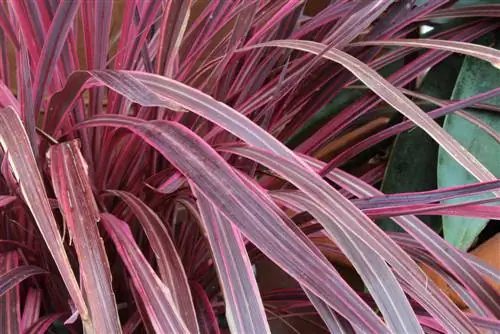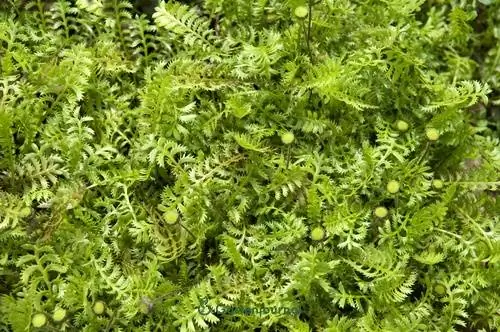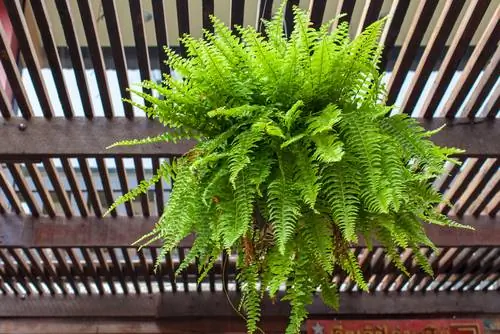- Author admin [email protected].
- Public 2023-12-16 16:46.
- Last modified 2025-01-23 11:22.
Read here in the commented club lily profile information about growth, flowering, leaves and winter hardiness. Lots of tips about the correct planting and club lily care as a container plant.

What is the club lily and how do you care for it?
The club lily (Cordyline australis) is an evergreen, woody plant from the Asparagus family. It grows up to 300 cm high, has sword-shaped leaves and fragrant panicle flowers. As a partially hardy potted plant, it is suitable for locations with high humidity, little direct sunlight and temperatures above freezing.
Profile
- Scientific name: Cordyline australis
- Family: Asparagus family (Asparagaceae)
- Origin: New Zealand, Australia
- Growth type: evergreen woody plant
- Growth habit: single-stemmed, dense tuft of leaves
- Growth height: 100 cm to 300 cm
- Leaf: sword-shaped
- Flower: panicle
- Fruit: Berry
- Winter hardiness: conditionally hardy
- Toxicity: non-toxic
- Use: potted plant
Growth
The club lily (Cordyline australis) is one of 24 plant species from the genus club lilies (Cordyline) within the Asparagaceae family. Since the beginning of the 19th century, Cordyline australis, which comes from New Zealand, has been highly valued in Europe as a decorative pot plant. With this growth, the club lily combines all the properties that hobby gardeners want from a representative ornamental plant all year round:
- Growth type: perennial, evergreen, herbaceous, woody plant with interesting inflorescences.
- Growth habit: upright, single-stemmed shoot axis with a terminal rosette of leaves, similar to a palm tree.
- Growth height as a container plant: 100 cm to 300 cm.
- Growth height in New Zealand habitat: 1,000 cm to 1,200 cm.
- Roots: club-shaped, white, edible storage tubers.
- Gardenically interesting properties: extremely robust, easy to care for, site-tolerant, partially hardy, fragrant flowers, tolerates cutting, non-toxic, accurate architectural appearance.
Video: Mighty club lily in a natural location
Bloom
In summer the club lily dresses up with these fragrant flowers:
- Inflorescence: richly branched panicles up to 100 cm long with numerous individual flowers.
- Single flower: tripartite, tubular.
- Flower color: cream white
- flower ecology: hermaphrodite
As a container plant, the club lily only puts on its fragrant white flower dress for the first time when it is older. Pollinated flowers turn into 6 mm small berries. The black seeds it contains are dark germinators.
Leaf
With these leaf characteristics, the club lily lives up to its reputation as a magnificent foliage plant:
- leaf shape: sword-shaped
- Leaf size: 70 cm to 120 cm long, 5 cm to 6 cm wide.
- Leaf color: Original species green, varieties red to dark crimson or green-white-cream colored.
- Consistency: leathery
- Special feature: edible
Evergreen club lily leaves do not have eternal life. Over the years, the lower leaves dry out and can be pulled off, revealing the woody, trunk-like shoot axis.
Winter hardiness
The club lily can tolerate a short-term minimum temperature of -5° Celsius. In the long term, the plant cannot survive temperatures below freezing. For this reason, Cordyline australis is cultivated as a container plant in this country.
Planting club lilies
Thanks to their high appreciation as impressive ornamental plants, ready-to-plant club lilies are available to buy almost all year round. Planting is cheaper after propagation by cuttings or sowing. The right location indoors or outdoors can be found quickly. Read useful planting tips here:
Propagation
Vegetative propagation through cuttings is promising. Generative propagation by sowing is time-consuming and has a high failure rate. The respective procedure for reading in brief:
- In early summer, cut 10-20 cm long shoot tips as cuttings, root them in coconut soil (€2.00 on Amazon) under foil at 24° to 28° Celsius and do not let them dry out.
- Sow dark-germinating seeds all year round 1.5 cm deep in seed soil and allow them to germinate in a heated propagation box at 28° to 30° Celsius within 6 weeks with high humidity.
Planting
High-quality potted plant soil and a mix of peat-free potting soil, coconut soil as a peat substitute and a handful of lava granules are suitable as a substrate. How to plant a club lily correctly:
- Cover the bottom of the bucket with expanded clay or pottery shards as drainage.
- Place the potted root ball in rainwater until no more air bubbles appear.
- Plant the potted club lily while maintaining the previous planting depth with a watering edge.
- Press down the potting soil and water thoroughly.
Extra tip: Place a water- and air-permeable fleece between the drainage and the substrate.
Location
The club lily is happy to keep you company all year round as a houseplant in living and working rooms, winter gardens and entrance areas. For the warm season, the potted plant would like to move to the balcony. These are the perfect conditions:
- Original species Cordyline australis: sunny, sometimes with direct sunlight for intense leaf colors.
- Colorful varieties and Cordyline fruticosa: light to partial shade with shading against full sun.
- Optimal temperatures from April to October: from 18° Celsius upwards.
- Advantageous temperature level from November to March: around 12° Celsius (Cordyline australis) or 16°-18° Celsius (Cordyline fruticosa).
- High humidity above 40 percent all year round.
Excursus
Club Lily Dragon Tree Difference
Club lily (Cordyline) and dragon tree (Dracaena) look very similar with their sword-shaped leaves. Only upon closer inspection do these differences become apparent even to the untrained eye: As a container plant, the club lily forms a single-stemmed, unbranched shoot axis with white, thick roots. The dragon tree usually thrives in a pot with multiple stems and branches with thin, yellowish-orange roots.
Care for the club lily
Club lilies are said to be undemanding in care. It is said that the potted plants are robust, “like an old leather boot”. It's still worth taking a look at these care tips for a Cordyline australis in top shape:
Pouring
- Do not allow root balls to dry out at any time of the year.
- Pour the substrate (finger test) if it is noticeably dry until the saucer fills up.
- Pour out the coaster as soon as possible or fill it with expanded clay as additional protection against waterlogging.
- Use low-lime irrigation water for water supply (rainwater, stale tap water).
- Spray the leaves occasionally with soft water.
Fertilize
From April to October, the club lily is fertilized weekly with a liquid fertilizer for green plants. During the dark season between November and March, add half the concentration of green plant fertilizer to the irrigation water every six weeks.
Cutting
Regular pruning care is not necessary. If necessary, you can cut the club lily like a dragon tree. These are the most important criteria for the right cut:
- Best time: in spring (small corrections are possible all year round).
- Pruning tools: knife, garden and pruning shears or folding saw; always freshly sharpened and disinfected.
- Cutting guide: Stabilize the shoot or shoot axis with one hand, place the cutting tool just above a leaf, sleeping eye or a bud.
Please do not cut off wilted leaves. Wait until a club lily leaf has completely died back and can be easily pulled off. Do this in the same way with the faded panicles. Your patience will be rewarded with densely bushy branching. After a while, the shoots will fork in the places where the flower spikes have withered.
Wintering
Due to its severely limited winter hardiness, the club lily relies on frost-free overwintering. The framework conditions have already been discussed in various places. In the following lines you will read a compact summary. This is how you overwinter Cordyline australis correctly:
- As a cold house species, club lilies overwinter brightly and coolly at temperatures between 5° and 15° Celsius.
- Winter care: water more sparingly, spray regularly, fertilize liquid every 6 weeks.
A temperature-controlled greenhouse and bright staircase as well as a wintering tent with a frost monitor or an unheated winter garden are suitable as winter quarters for Cordyline australis. In contrast, the Cordyline fruticosa, which is also popular as a pot plant, is a warm house species that is preferably overwintered at normal room temperatures.
Repotting
Every two to three years, the club lily benefits from a larger pot with fresh potting soil. The best time to repot is in spring, ideally in March or April. Please do not choose the new container too large. No more than two fingers should fit between the root ball and the edge of the pot. Subsequently, the club lily is not fertilized until the nutrient reserves in the substrate are used up after six to eight weeks.
Diseases, pests, care problems
If a club lily is weakened by dryness or waterlogging, cunning pests take advantage of the opportunity. It is primarily failures in the water supply that cause problems. The following table describes common damage patterns with their causes and gives tips for non-toxic countermeasures:
| malicious image | Cause | Countermeasure |
|---|---|---|
| Brown-yellow bumps and leaf spots | Scale insects (Coccoidea) | Inject soap-spirit solution |
| Webs, white dots | Spider mites (Tetranychidae) | shower vigorously (pack root ball in foil) |
| Tiny insects, sticky leaves | Aphidoidea | shower, spray soap-spirit solution |
| Accordion pleats | Water shortage | Dip root balls, water and spray more often |
| Floppy leaves, foul smell | Waterlogging | repotting, watering more sparingly |
| Yellowed leaves | irrigation water that is too hard | Use low-lime irrigation water |
Popular varieties
These beautiful club lily varieties and species vie for a place indoors or outdoors as a representative container plant:
- Atropurpurea: impresses with burgundy-red, elongated-narrow leaves and white flower spikes, growth height up to 300 cm.
- Variegata: Premium variety scores with yellow-green striped, heavy-shaped decorative leaves, growth height up to 300 cm.
- Red Star: Red club lily with dark red to purple sword leaves and palm-like stature.
- Cordyline fruticosa syn. Cordyline terminalis: rosette-like growth form, boasts lanceolate leaves up to 50 cm long and purple-colored leaf edges, height 100-200 cm, width 100-150 cm.
- Cordyline fruticosa 'Amabilis': magnificent club lily with shiny bronze-colored, pink shimmering, very wide, cream-colored leaves.
FAQ
Is Cordyline australis hardy?
The Cordyline australis is only partially hardy in our latitudes. If the potted plant is briefly exposed to temperatures below freezing point down to -5° Celsius, it can cope with the cold shock without any significant injuries. The New Zealand asparagus plant overwinteres best in light and frost-free conditions at temperatures of around 12° Celsius.
Is the club lily poisonous?
No, the club lily is not poisonous. On the contrary, some parts of the plant are edible. The natives of New Zealand make a tasty vegetable from the leaves. The root ball is served baked. The Maori make a sweetener from the starchy stems. With this in mind, Cordyline species are the ideal ornamental plants for the family garden with pets.
My club lily has brown leaves. What to do?
The club lily reacts to various location and care problems with brown leaves. The most common cause is too low humidity. In this case, spray the leaves regularly. To do this, use low-lime water. Furthermore, the leaves take on a brown color if the root ball has dried out or is waterlogged. If you notice that the ball is dry, dip the roots in room temperature rainwater. If waterlogging becomes apparent as the cause, you should repot the suffering club lily as soon as possible and water it more sparingly from now on.






